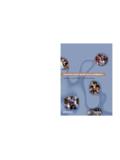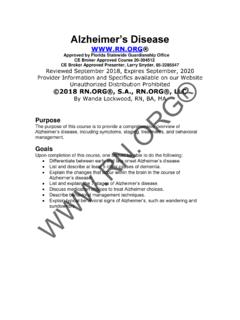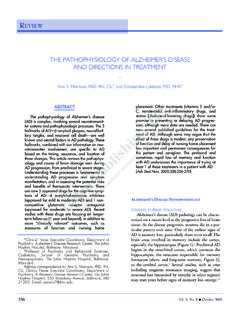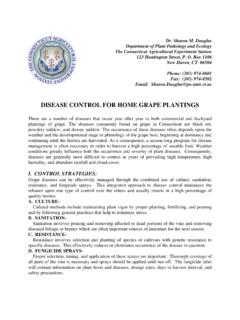Transcription of DISEASE CONTROL FOR HOME PEACH ORCHARDS …
1 Dr. Sharon M. Douglas Department of Plant Pathology and Ecology The Connecticut Agricultural Experiment Station 123 Huntington Street, P. O. Box 1106. New Haven, CT 06504. Phone: (203) 974-8601. Fax: (203) 974-8502. Email: DISEASE CONTROL FOR home PEACH ORCHARDS . There are a number of diseases that commonly occur year after year in both commercial and backyard plantings of peaches and nectarines. These diseases do not infect at the same time but appear in a fairly regular sequence depending upon the weather and the development or phenology of the stone fruit host, beginning at dormancy and continuing until fruit are harvested. As a consequence, a season-long program for DISEASE management is often necessary in order to harvest a high percentage of useable fruit. The diseases which are common on PEACH and nectarine include PEACH leaf curl, brown rot, perennial canker, and PEACH scab.
2 Weather conditions greatly influence both the occurrence and severity of plant diseases. Consequently, diseases are generally most difficult to CONTROL in years of prevailing high temperature, high humidity, and abundant rainfall and cloud-cover. I. CONTROL STRATEGIES: Stone fruit diseases can be effectively managed through the combined use of culture, sanitation, resistance, and fungicide sprays. This integrated approach to DISEASE CONTROL minimizes the reliance upon one type of CONTROL over the others and usually results in a high percentage of quality fruit. A. CULTURE- Cultural methods include maintaining tree vigor by proper planting, fertilizing, and pruning and by following general practices that help to minimize tree stress. B. SANITATION- Sanitation involves pruning and removing affected or dead portions of the tree and removing diseased foliage or fruit which are often important sources of inoculum for the next season.
3 C. RESISTANCE- Resistance involves selection and planting of varieties with genetic resistance to specific diseases. This effectively reduces or eliminates occurrence of the DISEASE in question. D. FUNGICIDE SPRAYS - Proper selection, timing, and application of these sprays are important. Thorough coverage of all parts of the tree is necessary and sprays should be applied until run-off. The fungicide label will contain information on plant hosts and diseases, dosage rates, days to harvest interval, and safety precautions. 2. II. COMMON DISEASES: A. PEACH LEAF CURL- PEACH leaf curl, caused by the fungus Taphrina deformans, is a springtime leaf DISEASE favored by relatively cool, wet spring weather. The fungus causes a thickened, reddish-purple discoloration of developing leaves. These leaves become puckered, primarily along the mid-vein, and appear distorted and stunted.
4 As these symptomatic leaves age, they become yellow to brown and drop from the tree. A second crop of leaves are subsequently produced which is not affected by the DISEASE . The fungus overwinters in the buds and infects newly developing leaves as the buds begin to swell in the spring. Infection only occurs during a relatively short time period as fungal spores are washed onto developing leaves by rain. Although this fungus rarely infects or causes symptoms on fruit, several years of uncontrolled heavy leaf infection can weaken the tree and effectively reduce its life span. Leaf curl is effectively controlled by properly selected and timed fungicide sprays. In fact, a single application can provide nearly total CONTROL . To be effective, the fungicide application must be made before the buds begin to swell- this can be done in late fall after the leaves have fallen or in early spring before the buds swell (refer to spray guide on page 5).
5 B. BROWN ROT- Brown rot, caused by the fungus Monilinia fructicola, is the most common and destructive DISEASE of stone fruits in Connecticut and New England. The DISEASE is especially severe in wet, humid weather. Brown rot causes blossom blights, twig blights, twig cankers, and fruit rots. Infected blossoms wilt, shrivel, and die, becoming covered with a grayish mold. Infection can then spread to the twig and form a brownish oval canker. These cankers can expand and eventually girdle the twig, causing the terminal growth to wither and die. On fruit, this DISEASE first appears as a small, circular brown spot that increases rapidly in size and eventually results in a soft rot of the entire fruit. Under wet, humid conditions, ash-gray, powdery tufts appear all over the surface of the fruit, a characteristic diagnostic symptom of this DISEASE .
6 Fruit decay is often not apparent on green fruit but becomes obvious as fruit begin to mature and ripen. Fruit which are wounded (by insects, mechanical injury, bird pecks, etc.) are more readily infected than unwounded fruit. Rotted fruit may fall to the ground or persist as mummies on the tree. The fungus overwinters in fruit mummies on the tree or ground and in twig cankers. In spring, the fungus produces two types of spores; one type is produced on the surface of cankers and mummied fruit on the tree and the other type is produced in mummied fruit on the ground. Both spore types can cause infection under warm, moist conditions. Sanitation is essential to CONTROL of brown rot. Any mummied fruit that remain on the tree should be removed and destroyed and all dead and/or cankered twigs should be pruned and removed from the vicinity of the tree or planting.
7 In addition, all mummied fruit on the ground should be raked and removed and/or the ground beneath the tree cultivated to prevent spores from forming on the mummies in the spring. At harvest, care should be taken to avoid bruises, punctures, or tears in the skin of mature fruit to prevent sites for potential infection. In conjunction with this sanitation program, a season-long fungicide spray program is usually necessary for effective brown rot CONTROL . Properly selected and timed fungicide applications should be made to protect blossoms, foliage, and fruit throughout the growing season (refer to spray guide on page 5). 3. C. PERENNIAL CANKER- Perennial canker, caused by two related fungi Leucostoma cinta and L. persoonii, is also known as Valsa canker, Cytospora canker, and PEACH canker. This DISEASE is a particular problem in New England since it is more serious on trees which have been weakened or damaged by cold stress.
8 These fungi cause cankers that first appear as sunken areas in the wood which exude considerable gum. These are oval to linear in outline and are eventually surrounded by a roll of callus at the canker margins. These cankers increase in size each year and often completely girdle a limb or an entire trunk. The fungi overwinter in cankers or on dead wood. Spores called conidia are produced and carried by splashing and wind-driven rain and/or wind. Infection requires moisture and takes place through a variety of different avenues, including winter injuries, pruning stubs, mechanical damage, insect punctures and leaf scars. A multifaceted approach is necessary to CONTROL this DISEASE . Pruning of trees should be delayed until March or April or later, if possible, to promote early healing of wounds. Any cankers or dead wood should be pruned and removed from the vicinity of the planting.
9 All efforts to avoid mechanical damage, to maintain the vigor of the tree by proper application and timing of fertilization, and to protect the tree from insect and other injuries should be made. Protective fungicide sprays have not been found to be of value. D. PEACH SCAB- PEACH scab, caused by the fungus Cladosporium carpophilum, is most often a problem in warm, wet weather following shuck-split and is also known as ink spot. Although the fungus infects leaves and twigs, DISEASE symptoms are most often observed on the fruit. Early infection appears on the fruit as small. circular green spots concentrated at the stem end. These spots usually don't appear until the fruit are half grown. Older lesions appear as dark green-black velvety blotches that, as they coalesce, often cause cracks in the skin and flesh. Infections on twigs and leaves are inconspicuous and appear as green-brown superficial lesions.
10 The fungus overwinters in lesions on twigs and in spring, produces spores called conidia. These conidia are washed and splashed by rain to twigs, fruit, and leaves where they cause new infections. Forty to 70 days elapse from the time the conidia land on the fruit until the DISEASE symptoms are visible so the DISEASE can go unnoticed until the fruit are well grown. Sanitary practices such as pruning and removing symptomatic twigs help to reduce overwintering inoculum. However, scab is primarily controlled with fungicide sprays (refer to spray guide on page 5). III. SPRAY GUIDE: A. PESTICIDES- A general purpose tree fruit spray, available under a variety of trade names, is effective for CONTROL of many of the common diseases and insect pests of PEACH and nectarine. This mixture usually contains captan as the fungicide component and methoxychlor and malathion or carbaryl as the insecticide component.
















